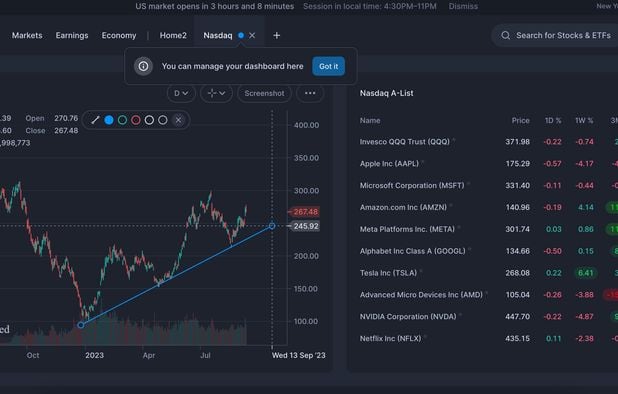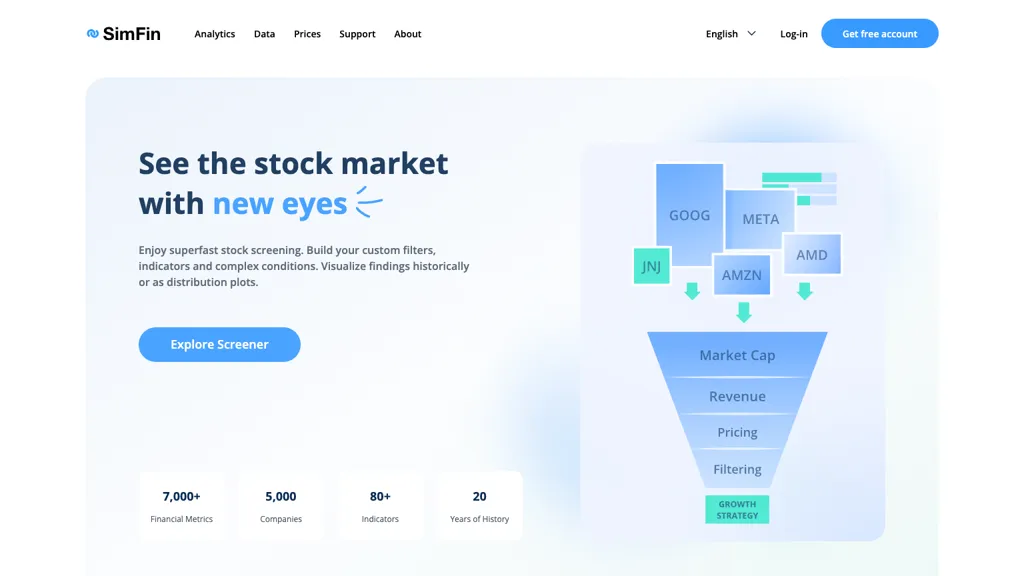Examining the price and cost of AI software for predicting and analyzing stocks is vital to ensure you get value for your money while avoiding hidden fees or unanticipated expenses. Pricing structures can vary greatly and it is essential to be aware of what you're getting for the amount you pay. Here are the 10 best tips for evaluating price and cost.
1. Learn Pricing Model
Subscription-based: Check if the platform charges monthly or annually, and also the features that each tier offers.
Pay-per-use: Determine whether you are charged according to the use of the platform (e.g. the number of transactions or requests for data).
Freemium: Find out the extent to which a platform provides a limited free tier and adds additional charges to access premium features.
2. Compare Pricing Tiers
Compare the features of each price tier, e.g. Basic, Professional, Enterprise.
Scalability. You must ensure that you are getting the best price to meet your requirements.
Upgrade flexibility: See if it is possible to upgrade or downgrade the plan as you change your needs.
3. Evaluate Hidden Costs
Fees for data. Check if the platform charges a fee for access to premium data.
Brokerage charges: Find out whether the platform charges additional charges to conduct trades or connect with brokers.
API usage: Determine whether the cost of API access is more expensive or if API use is frequent.
4. Check out free demos as well as trials
Trial period. Find platforms that offer trials or demos so that you can test their services before committing.
Trial limitations: Make sure to check whether the trial you are using is included in all of the features, or if it is limited in functionality.
Optional with no commitment The user should be able to cancel your trial without incurring charges if you find that the software does not satisfy your needs.
5. Take a look at the latest deals and special offers
Discounts on annual subscriptions The monthly plan is compared to the annual plan.
Referral Programs Find out if your platform offers discounts or credits to users who refer others.
Institutional pricing If you're part of a larger organization, inquire about bulk or institutional pricing.
6. Assess Return on Investment
Value and cost: Examine the cost of a platform versus its features. It could help you save money and improve your trading strategies.
Record of performance: Check the platform's success rate or testimonials from users to determine the potential return on investment.
Alternative costs Costs of the platform: Compare its cost to the cost that could be incurred by not making use of it (e.g. missed opportunities, manual analysis time).
7. Review and review cancellations and refunds Policies
Terms of cancellation: Be sure you're able cancel without any hidden fees or penalties.
Refund policy: Find out what the policy is for refunds. you for any unused portions.
Auto-renewal: Check whether the platform auto-renews your subscription, and how you can opt out.
8. Price transparency is essential.
Clear pricing page: Ensure that the platform offers a pricing page which is detailed, clear and does not contain any hidden fees.
Customer service: If you have any questions about the cost of services or other charges, please contact customer support.
Terms of the contract: Make sure you understand the service terms and any fines.
9. Compare to Competitors
Feature comparison Comparison of pricing and features offered by the platform to its rivals to make sure you're getting the most value for money.
Reviewer reviews: Check out the feedback of users to determine whether the cost of the platform is a good value.
Market positioning: Check if the platform is priced as premium, mid-tier or budget option, and if it is in line with your expectations.
10. Cost estimates for Long-Term
Price hikes: Check out the past history of the platform and observe how often it has raised prices.
Feature additions - Determine whether the new features are part of your current plan, or if an upgrade is needed.
Scalability Costs: Make sure the pricing of your platform is reasonable as your trading activity or demands for data increase.
Bonus Tips
Free trials for multiple platforms are available to try and evaluate the benefits and performance of different platforms.
Price negotiation: If you are an institution is large user, it's worth seeking out discounts or custom pricing.
Find educational resources on the internet Certain platforms provide free educational resources or tools which can be valuable beyond their core features.
With these suggestions, you can effectively assess the price and cost of AI platform for predicting and analyzing stocks and ensure you select one that's within your budget and offers the features and performance you want. A well-priced trading platform will find the perfect balance between features and affordability that will allow you to maximize your success. Read the top inciteai.com AI stock app for site tips including AI stock, market ai, best AI stock trading bot free, investment ai, ai trade, trading with ai, investing ai, ai investing app, best ai trading app, incite and more.

Top 10 Tips To Assess The Risk Management Capabilities Of Ai Stock Predicting/Analyzing Platforms
Risk management plays a crucial function in any AI-based platform for trading stocks. It safeguards your investment by minimizing possible losses and helps you to maximize profits. Platforms with strong risk management tools can assist you in navigating turbulent stock markets and make an informed decision. Below are the top ten tips for assessing risk management capability of these platforms.
1. Analysis of Stop-Loss and Take-Profit Features
Configurable settings: Ensure that you can set the maximum take-profit and stop-loss levels for a specific trade.
Check the platform to see whether it has a trailing stop feature which adjusts automatically when the market moves towards you.
It is important to determine whether there are stop-loss strategies that ensure that your position will be closed at the specified rate, even if markets fluctuate.
2. Calculate Position Size Tools
Fixed amount: Make sure the platform lets you define the positions you want to take based upon a sum of money fixed.
Percentage of your portfolio: See whether you are able to set position sizes as a percentage of your total portfolio to control risk in a proportional manner.
Risk-reward: Make sure your platform lets you determine risk-rewards for each strategy or trade.
3. Make sure you check for support for Diversification.
Multi-asset Trading: To diversify your portfolio of investments, be sure that the platform you select supports trading in multiple asset classes.
Sector allocation Check to determine what tools are that can be used to manage and monitor sector exposure.
Diversification of the geographic area. Find out whether your platform permits you to trade on international markets. This will help spread the geographic risk.
4. Review leverage and margin controls
Margin requirements: Ensure the platform is clear about margin requirements for trading leveraged.
Examine the platform to determine if it allows you to limit leverage in order to reduce the risk.
Margin calls - Check to see if your platform informs you about margin calls promptly. This will help prevent liquidation.
5. Assess the Risk Analytics Reporting
Risk metrics: Ensure whether the platform has key risk metrics like Sharpe ratio, as well as Drawdown for your portfolio.
Scenario Analysis: Determine whether your platform has the ability to simulate various market scenarios in order to assess possible risks.
Performance reports: Find out if the platform offers detailed performance reports that include the risk-adjusted return.
6. Check for Real-Time Risk Monitoring
Monitoring your portfolio. Be sure your platform can monitor the risk in real-time of your portfolio.
Alerts: See if you are receiving real-time notifications for at risk (e.g. stop-loss triggers, breach of margins).
Risk dashboards: Find out if the platform offers customizable risk dashboards for a comprehensive view of your risk profile.
7. Test Stress Testing and backtesting
Stress testing. Check that your platform allows you to test your strategy or portfolio under extreme market circumstances.
Backtesting. Verify that the platform permits backtesting. This is the use of historical data to assess the level of risk and performance.
Monte Carlo Simulations: Check whether the platform uses Monte Carlo simulations in order to assess and model various possible outcomes.
8. Risk Management Regulations: Assess the compliance
Compliance with regulatory requirements: Ensure that the platform is compliant with the applicable risk management regulations in Europe and the U.S. (e.g. MiFID II).
Best execution: Make sure that the platform is in line with the best execution methods. It will guarantee that transactions are completed to the highest price possible to minimize loss.
Transparency: Verify that the platform provides transparency and clear disclosures about the risks.
9. Look for parameters controlled by the user.
Custom Risk Rules: Ensure that you can define custom rules for managing risk (e.g. an amount that is the maximum loss per day, a maximum size of a tradable position).
Automated risk control: Determine whether the platform can automatically apply rules to manage risk based on your defined parameters.
Manual overrides - Check to see if the platform permits you to manually bypass automated risk controls.
Reviews of User Feedback and Case Studies
User reviews: Read feedback from users and evaluate the effectiveness of the platform in managing risk.
Case studies: Look for case studies or testimonials highlighting the platform's risk management capabilities.
Community forums: Check if a platform has members who are willing to share their strategies and suggestions for managing the risk.
Bonus Tips:
Trial time: You can make use of a demo or a no-cost trial to try out the risk management tools on the platform.
Support for customers: Ensure that you have a reliable support system for risk management-related problems or queries.
Educational resources - Check to see whether the platform provides educational resources and tutorials on best practices in risk management.
Use these guidelines to evaluate the risk management capabilities of AI trading platforms which predict and analyze stock prices. Select a platform that has the highest quality of risk-management and you will minimize your losses. It is vital to have robust risk-management tools to be able to navigate volatile markets. View the most popular continue reading this on how to use ai for stock trading for site recommendations including best stock prediction website, ai trading tool, can ai predict stock market, trading ai tool, AI stock price prediction, free ai tool for stock market india, AI stock price prediction, ai options, AI stock price prediction, can ai predict stock market and more.
